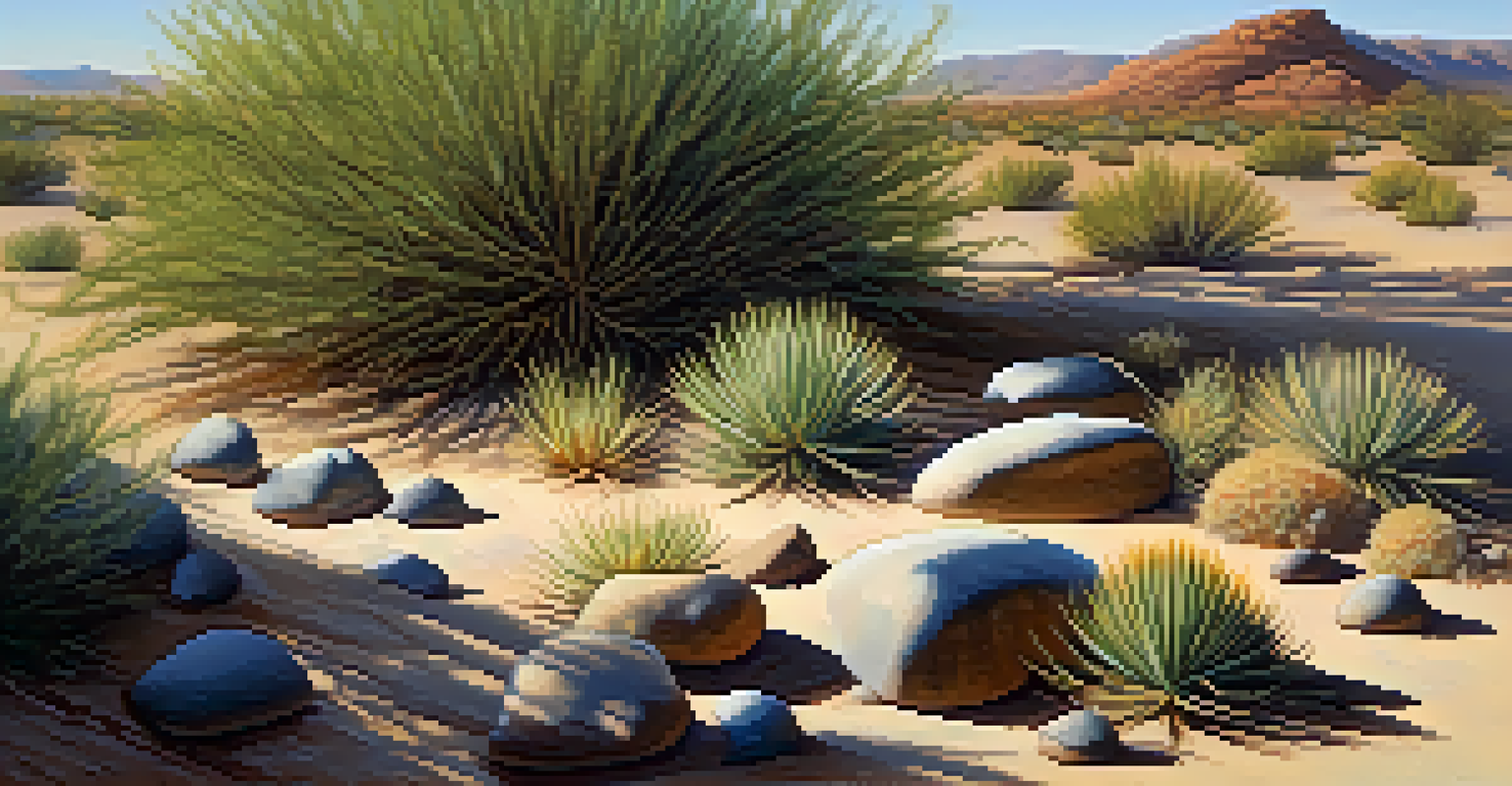Desert Plants: Surviving Extreme Temperatures and Dry Conditions

Understanding the Desert Environment and Its Challenges
Deserts are fascinating ecosystems characterized by extreme temperatures and minimal rainfall. These harsh conditions create a unique environment where only the hardiest plants can survive. With daytime temperatures soaring and nighttime temperatures plummeting, plants must adapt quickly to these fluctuations to thrive.
In every walk with nature one receives far more than he seeks.
The average annual rainfall in deserts is often less than 10 inches, making water conservation a priority for desert flora. Plants here face not just heat but also competition for limited resources. Therefore, their survival strategies are incredibly specialized and efficient.
To truly appreciate how these plants endure such a challenging habitat, we need to delve into their remarkable adaptations. From unique structures to specialized processes, desert plants have developed ingenious solutions that allow them to make the most out of their arid surroundings.
Water Conservation: The Key to Survival
Water is the lifeblood of any plant, but in deserts, it's a precious resource that must be conserved. Many desert plants, like cacti, have evolved thick, fleshy tissues that store water efficiently. This adaptation allows them to survive long periods without rainfall, essentially acting as a reservoir.

Moreover, some desert plants have developed shallow root systems that spread widely to capture any moisture that does occur, while others grow deep roots to tap into underground water sources. These strategic adaptations highlight the importance of water conservation in their survival.
Desert Plants' Water Conservation Tactics
Desert plants have evolved unique adaptations, such as thick tissues and strategic root systems, to effectively conserve water in their harsh environments.
By minimizing water loss through specialized structures such as waxy coatings or reduced leaf sizes, these plants can withstand prolonged droughts. This ability to conserve water becomes a fascinating aspect of their biology and a key factor in their survival strategy.
Physical Adaptations of Desert Plants
Desert plants exhibit a variety of physical adaptations that help them withstand extreme conditions. For instance, many have thick, waxy skins that reduce water loss, acting like a protective barrier against the relentless sun. This outer layer is vital for maintaining hydration within the plant.
The desert tells a different story every time one ventures on it.
Additionally, some plants have spines or thorns instead of leaves, which not only deter herbivores but also minimize surface area and reduce transpiration. These adaptations are perfect examples of how evolution has tailored plant features to suit their environments.
Other plants, like the iconic saguaro cactus, have accordion-like structures that allow them to expand and store water when it rains. These clever physical traits enable desert plants to thrive despite the odds stacked against them.
Reproductive Strategies in Harsh Conditions
Reproduction is a critical phase in the life cycle of any plant, but desert plants face unique challenges in this area. Many have adapted by timing their flowering and seed production to coincide with rare rainfall events. This ensures that their offspring have the best chance of survival.
Some species produce seeds that can remain dormant for years, waiting for the right conditions to sprout. When the rains do finally come, these seeds burst into life, taking advantage of the sudden availability of water and nutrients.
Survival Strategies in Harsh Conditions
Many desert plants time their reproductive cycles to coincide with rare rainfall, ensuring the survival of their offspring in unpredictable climates.
These reproductive strategies illustrate the resilience of desert plants. By being opportunistic, they can ensure their continuation in a landscape where unpredictability is the norm.
Photosynthesis Adaptations for Desert Life
Photosynthesis is the process through which plants convert sunlight into energy, but desert plants have developed unique methods to optimize this process under extreme conditions. Many utilize a modified form of photosynthesis known as CAM (Crassulacean Acid Metabolism), which allows them to open their stomata at night to minimize water loss.
During the day, when temperatures soar, these plants keep their stomata closed, conserving precious water while still capturing sunlight. This clever adaptation helps them survive in environments where water is scarce and heat is intense.
By adjusting their photosynthetic methods, desert plants demonstrate incredible ingenuity. This ability to adapt their energy production to suit their environment is a testament to their resilience.
The Role of Microclimates in Desert Ecosystems
Microclimates are small, localized areas within a larger ecosystem where conditions differ from the surrounding environment. In deserts, these microclimates can provide crucial refuges for plants and animals, offering slightly more favorable conditions for survival.
For example, a cluster of rocks may create shade and retain moisture, creating a microhabitat where certain plants can thrive. These pockets of life are vital to the overall ecosystem, supporting biodiversity in an otherwise harsh environment.
Human Impact on Desert Ecosystems
Human activities, including urban development and climate change, threaten the survival of native desert plants and disrupt their delicate ecosystems.
Understanding the role of microclimates helps us appreciate the complexity of desert ecosystems. They allow for a greater variety of life forms, showcasing how even the most challenging environments can harbor diverse plant species.
Human Impact on Desert Plant Survival
While desert plants have evolved to survive extreme conditions, human activities pose significant threats to their existence. Urban development, agriculture, and climate change can disrupt delicate desert ecosystems, leading to habitat loss and increased stress on these resilient species.
As we expand into desert areas, we often overlook the native plants that have adapted over millennia. The introduction of non-native species can further complicate the survival of local flora, as they compete for resources and space.

Recognizing the importance of desert plants in maintaining ecological balance is crucial. By taking steps to protect these environments, we can help ensure that these incredible plants continue to thrive for future generations.
The Future of Desert Plants in a Changing Climate
As global temperatures rise and weather patterns shift, the future of desert plants hangs in the balance. Some species are already showing signs of stress due to increased heat and prolonged droughts, which could threaten their survival. Understanding how these plants respond to climate change is essential for conservation efforts.
Research into the adaptability of desert flora can provide insights into how they might cope with changing conditions. Some may develop new strategies, while others may struggle to survive, highlighting the importance of biodiversity in maintaining resilient ecosystems.
Ultimately, the fate of desert plants is interconnected with our actions. By fostering a greater appreciation for these remarkable organisms and their adaptations, we can work towards preserving their habitats and ensuring their survival in an uncertain future.